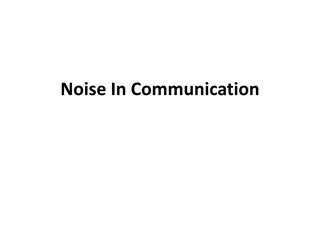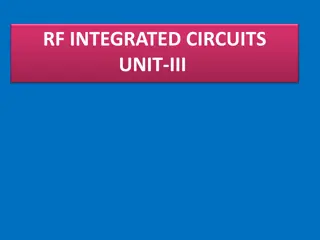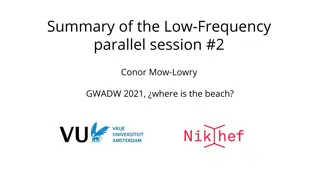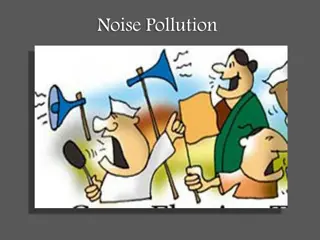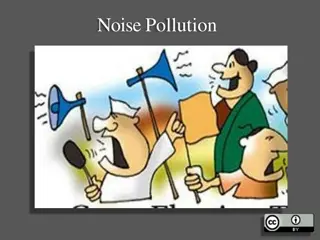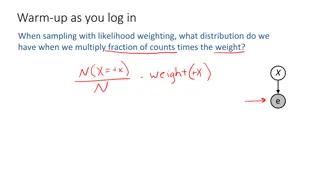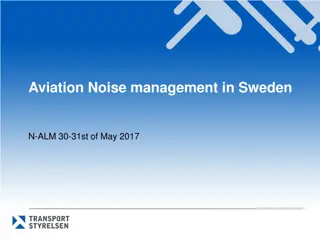Understanding Frequency Weighting in Noise Pollution Measurement
Frequency weighting is essential in noise pollution measurement to reflect how the human ear perceives noise. The A, C, and Z weightings are commonly used to represent different frequency responses. A-weighting covers the audible frequencies where the human ear is most sensitive, while C-weighting is closer to linear values, and Z-weighting provides a flat frequency response. These weightings are defined in standards such as IEC 61672:2003, specifying their performance and tolerances. The equivalent continuous noise level (Leq) and noise exposure from single discrete events are also key metrics in noise measurement.
Download Presentation

Please find below an Image/Link to download the presentation.
The content on the website is provided AS IS for your information and personal use only. It may not be sold, licensed, or shared on other websites without obtaining consent from the author. Download presentation by click this link. If you encounter any issues during the download, it is possible that the publisher has removed the file from their server.
E N D
Presentation Transcript
Lec.3 Noise Pollution 4th year 3.1 Frequency weighting 1- A Frequency Weighting A Weighting is standard weighting of the audible frequencies designed to reflect the response of the human ear to noise. At low and high frequencies, the human ear is not very sensitive, but between 500 Hz and 6 kHz the ear is much more sensitive. The A weighting filter covers the full frequency range of 20 Hz to 20 kHz, but the shape approximates to the frequency sensitivity of the human ear. So, the A-weighted value of a noise source is an approximation to how the human ear perceives the noise. Measurements made using A-weighting are usually shown with dB(A) to show that the information is A weighted decibels or, for example, as LAeq, LAFmax,etc where the A shows the use of A-Weighting. Frequency Weighting Curves A , C & Z 1
2- C Frequency Weighting C Weighting is a standard weighting of the audible frequencies commonly used for the measurement of Peak Sound Pressure level . And is the closest to the linear or unweighted value . Measurements made using C weighting are usually shown with dB(C) to show that the information is C weighted decibels or, for example, as LCeq, LCPeak, etc where the C shows the use of C Weighting. 3- Z Frequency Weighting Z weighting is a flat frequency response between 10Hz and 20kHz 1.5dB excluding microphone response. Measurements made using Z weighting are usually shown with dB(Z) to show that the information is Z weighted decibels or, for example, as LZeq, etc where the Z shows the use of Z Weighting. Or zero weighting Frequency Weighting Curves A , C & Z 2
3.2Where these Frequency Weightings are defined All of these frequency weightings are defined in the standards to which a noise measurement instrument is designed (An electronic filter built into sound level meter ). For example, the frequency weightings used on a sound level meter will be defined in IEC 61672:2003 (BS EN 61672-1:2003 ). This standard specifies the performance and tolerances for the frequency weighting curves to be used. Frequency Weightings defined in IEC 61672:2013 Frequen cy (Hz) 63 125 250 500 1k 2k 4k 8k 16k A- weighti ng (dB) 26.2 16.1 8.6 3.2 0 + 1.2 + 1.0 -1.1 6.6 C- weighti ng (dB) 0.8 0.2 0 0 0 0.2 0.8 3.0 8.5 Z- weighti ng (dB) 0 0 0 0 0 0 0 0 0 3
3.3 Equivalent Continuous Noise Level The equivalent continuous level Leq, is the sound pressure level of a steady sound has over a given period, is measured in dB(A). ???1 10 + ?2 10 ???2 10 + ???= 10log?1 10 ? Leq is the equivalent continuous A-weighted sound pressure level , dB t1, t2, T is the time interval ,hr ????1 ????2= 10log?2 ?1 4
3.4 Noise Exposure from Single Discrete Events The sound exposure level LAE, of a single discrete noise event is the level which if mentioned constant for a period 1sec would contain as much A-weighted sound energy as is contained in the actual noise event. LAE= LAeq,T+ 10logT Where T must be in seconds LAE value can be used to calculate the value of LAeq,T when N identical evets all having the same LAE value occur within time T: ????,?= ???+ 10???? 10???? 5
3.5 Day-Night Level It is a single descriptor to cover the 24-hr period with a weighting factor of (10 dBA) for noise over the nine-hour period between 22:00 and 07:00 hr. ?? 10+9 10 24 ??+10 10 15 10 ???= 10log Ld= The Leq over the period 07:00 22:00 local time. Ln= The Leq over the period 22:00 07:00 local time. 3.6 Day-Evening-Night Level It is a single descriptor to cover the 24-hr period but allows for the varying annoyance for the day, evening and night with a weighting factor of (5 dBA) for evening and (10 dBA) for night. ???? 10 ?????+5 10 ???? ?+10 10 12 10 + 4 10 + 8 10 ????= 10log 24 Lday= The Leq over the period 07:00 19:00 local time. Levening= The Leq over the period 19:00 23:00 local time 6 Lnight= The Leq over the period 23:00 07:00 local time
3.7 Day and Night Levels Ld= Leq,16hr=The Leq over the period 07:00 23:00 local time Ln= Leq,8hr=The Leq over the period 23:00 07:00 local time 7



